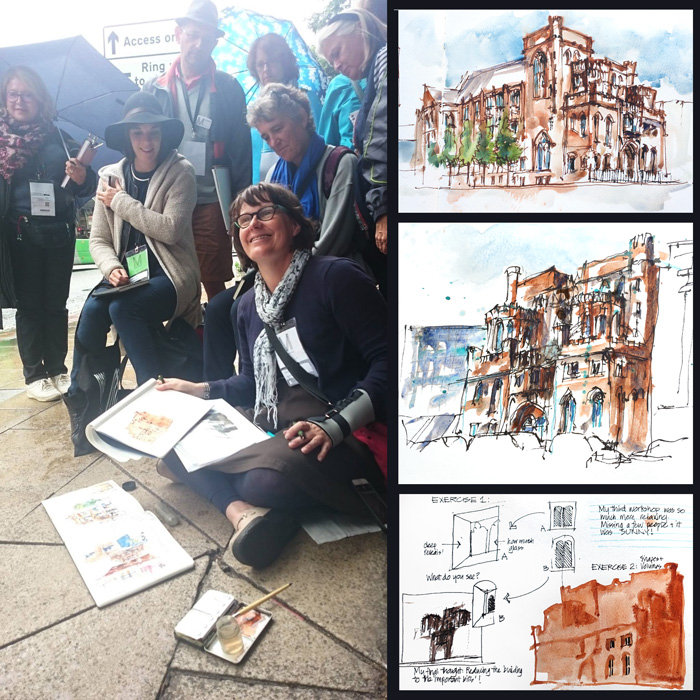
Following on from a description of what I taught in the Manchester Urban Sketchers Symposium, I want now to write about what it is like to be an instructor. It is always an enormous honour and privilege to teach at a USK Symposium – definitely a highlight of my year!
I run my own 1 -3 day sketching workshops so I’m quite used to all the challenges of teaching out on location, but there are unique features of a USK symposium that makes it different.
- You don’t have a long time with each group. It’s only a 3.5 hour session, and often 30 minutes is taken up by collecting the group and arriving on location. This year in Manchester my location was the farthest away from the School of Art and we had a specially hired bus (thanks Simone!) to get us there. This took a bit of time but was much better than trying to keep the group together for a 20 minute walk.
- The time period means that you need to have a very targeted programme – not too much and not too little – as you only have a short amount of time in order to give the most value to everyone. When you have a longer format you can have different paced sessions (I normally have a busy morning and a more relaxed afternoon).
- You don’t know who is going to be in your group and what the level of experience will be of the mix. This can vary between group to group (eg. in Singapore last year I had a much more advanced group in the morning and a predominately beginner group in the afternoon). You have limited opportunities to get to know this ‘experience level’ – sometimes I adjust the material slightly (ie. add more explanation or skip the more advanced concepts) depending on the group, but I can only do that after I see how they go with my first exercise.
- Because of this mix of experience it’s good to prepare content that can suit anyone from beginners to advanced and developing a few conceptual exercises is a good way to do this. I think the symposium is all about collecting a whole heap of ideas to take home and absorb into your own work. Sure you pick up new techniques but often it’s the ideas that stick with you the most.
- There are language and cultural differences within the group. There are many non-native English speakers at the symposium and lots of different accents. But despite the language differences we can all communicate via sketching! It’s therefore important to present the content in a visual way by means of examples and demonstrations – especially for the exercises so everyone can see what they are supposed to do.
- You make a proposal more than 6 months in advance, are allocated a location but are not really able to pull it all together until you arrive in the city a day or two before the symposium starts. It is very important as an instructor to arrive in the city early so you can prepare and get over the jetlag.
- You normally have to check the location twice – once in the morning and then in the afternoon as the conditions can be quite different
Aside: I now know not to have any exercises that are dependent on specific light conditions. In my own workshops I normally plan the subjects based where the sun is at the specific time of the exercise – shining on my subject and viewed from a comfortable shaded position for the group to sit.
- And of course you have to plan for wet weather – always hoping that it won’t rain, but never quite sure where you will be able to shelter due to the wind direction, or the reaction of security guards, shop/cafe owners etc.
- You are in a foreign city and have to be highly alert to everything around you. Having a local assistant (these are not always available) makes a huge difference as they can help keep an eye on things and help out if necessary.
- You have to be prepared for split-second decisions and changing your material if something happens. Getting up and moving the group takes time and can disrupt the workshop. In a normal workshop when you have the group for a full day (or longer), a disrupted session can be offset by the rest of the workshop, but in a USK symposium you only have each group for one session, so you really want to give them the best you can.
- The groups are large – 15-16 people – and you have to work really hard to get around to see everyone and give them all some one-on-one time. When you do a demo, will everyone be able to see you? I am used to 12 people and find the extra 3 or 4 persons makes a difference – non-stop all the time!
- Teaching two workshops in the one day is much more tiring than a single full day as the intensity has to be maintained both morning and evening. No relaxing free choice afternoon sessions! Added to that is the fact that you might have gotten up early to sketch for yourself or been out late-ish the night before having a group dinner. And in between the teaching you are meeting people every second step!
Ah! its great!
My Workshop
As I mentioned at the time, I found Thursday, Day 2 of the Manchester symposium, to be the most challenging day of teaching I have had to date. So I thought I would share some of the logistics involved in my location.
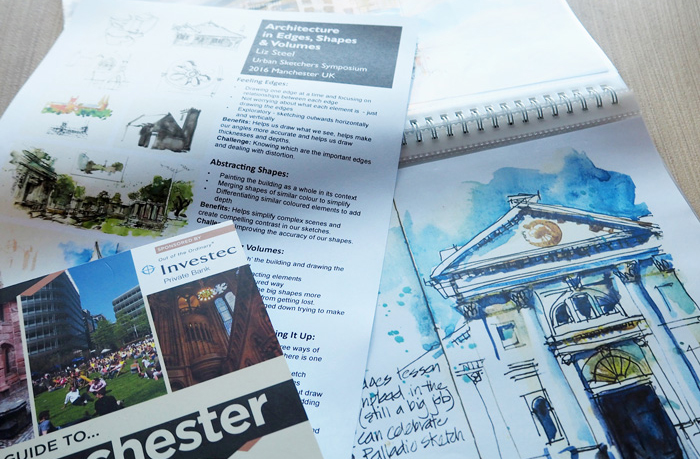
Preparations months before
Due to my long trip before the symposium I prepared my workshop 2 months in advance. I made the handout and my folder of examples rather conceptual and not specific to my location. I had a plan for the workshop but really needed to check out the location – John Rylands Library and its surrounds – before I could finalise it. There is only so much that you can do via Google street view!
First visit to my location – casing the joint
I arrived early in Manchester and on the second day visited my site to work out what to do for my exercises. Finding quiet time to prepare for your workshop can sometimes be challenging when the city is alive with Urban Sketchers so I try to do it as early as I can. It is important for me to connect personally with my location before getting into teacher mode so I first sketched the building ‘just for me’.
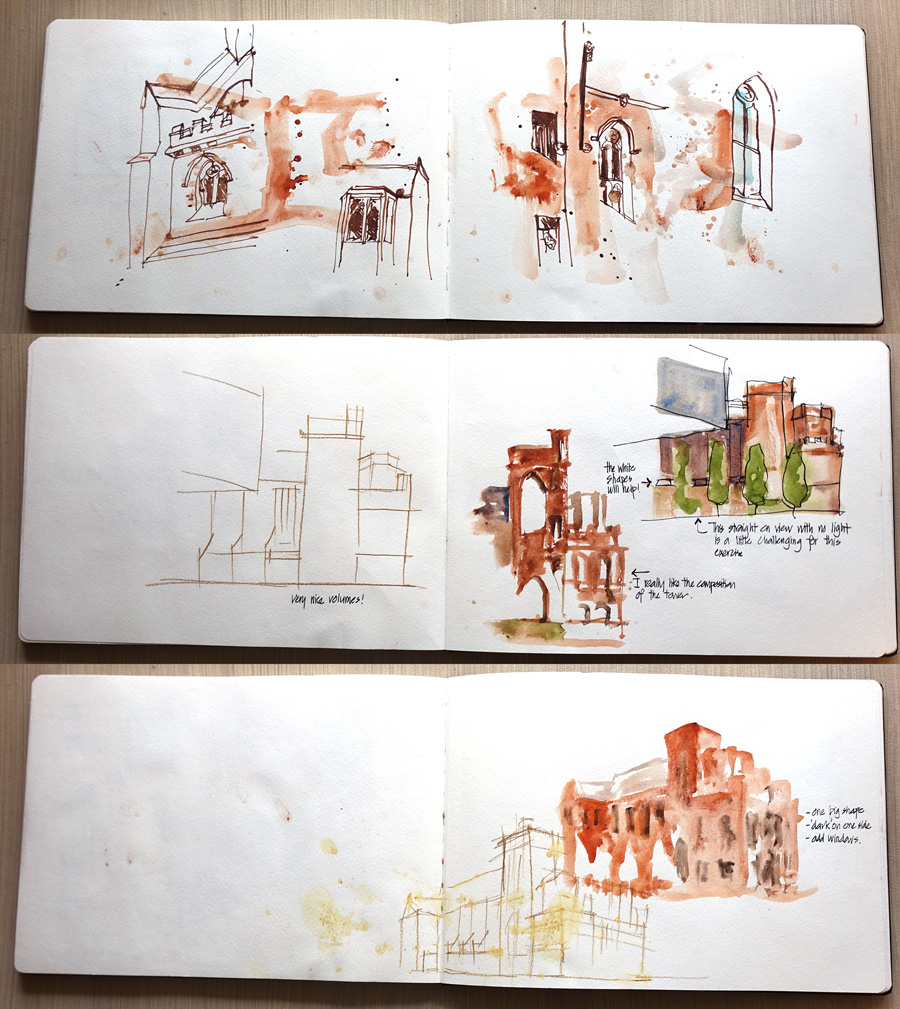
The open space to the south of the building would work well and I tested the location from sitting under an overhang of a nearby modern building (part of Spinningfields) and worked out that if it rained we could use this area. Not perfect but do-able. Here are my preliminary sketches from the preferred and then the wet-weather locations.
Second visit to my location – coordination with other instructors
There is often another workshop in the same general location so this needs to be sorted. I met up with Nina two days later and we decided that she would have her group on the opposite corner to the south (where I drew from on my first visit) and I would have a more oblique view on the opposite side of the road to the north(below). The location I had previously worked out wasn’t going to work as there had been issues with the Spinningfields security guards during a sketchcrawl the day before.
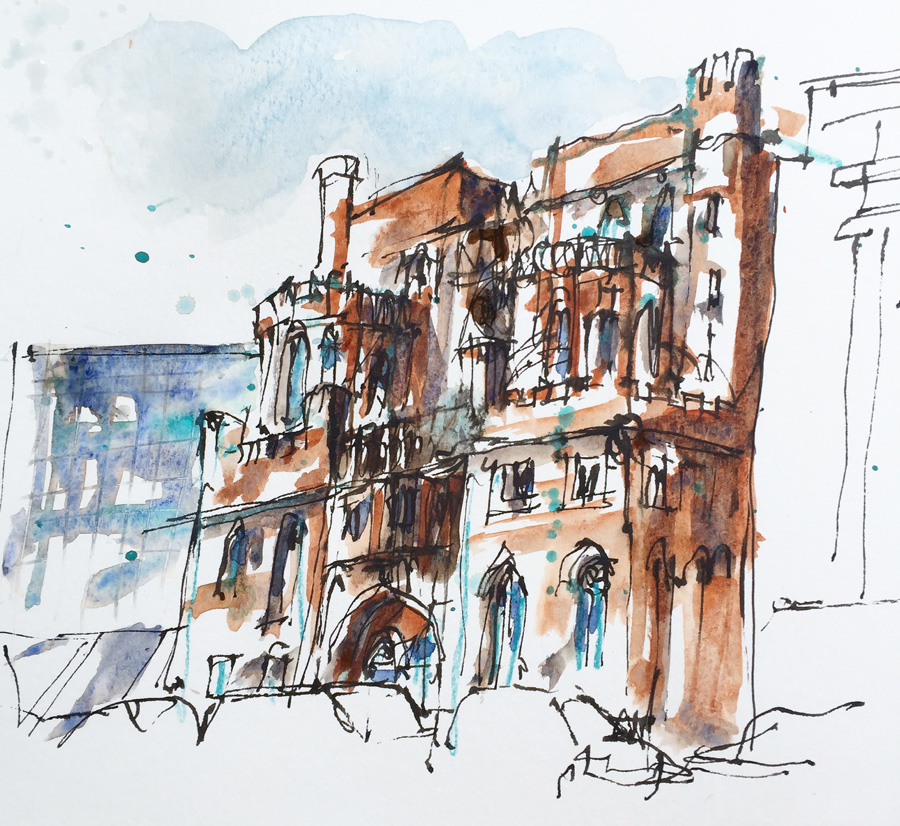
Third visit to my location – checking afternoon light and wet weather options more carefully
The weather forecast said 100% chance rain so I knew I needed to be serious about my wet weather plan. I also had one afternoon session so I wanted to check (one more time) what it was like after lunch. There were some narrow scaffolded sheltered areas, a tree and an awning which I thought would be adequate – just! I then did another sketch just for myself of my workshop view. I don’t always visit the site three times like this – normally only twice – but I’m very glad I made that third visit.
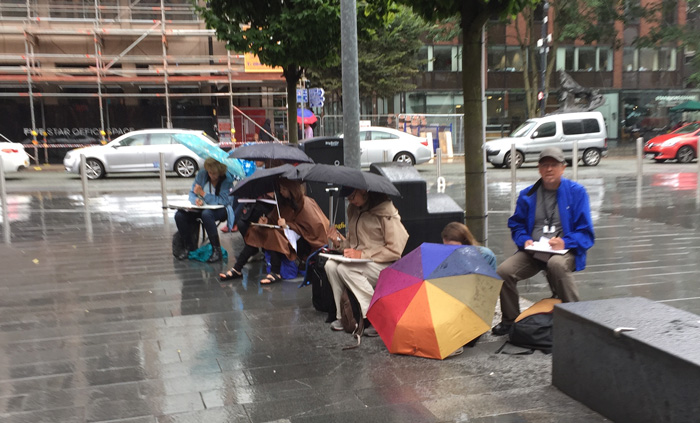
First workshop – rain disruptions and improvisation
On the Thursday morning, the first workshop, after a delay in the bus turning up, we finally got to our workshop location. There was rain forecast mid morning but as it was dry at the start I decided to sit out in the plaza just outside John Rylands but not on the Spinningfields site (or so I thought). This was a split minute decision to make the most of the dry weather.
Guess what? It started to rain after a few minutes (umbrellas up) and the security guard came up to ask if I had approval. He gave me a phone number to call but we basically just finished the exercise and then moved across the road to the sheltered area. This caused a bit of disruption to the morning session and when you are focused on delivering your content within the time slot, you have to remain calm and keep going.
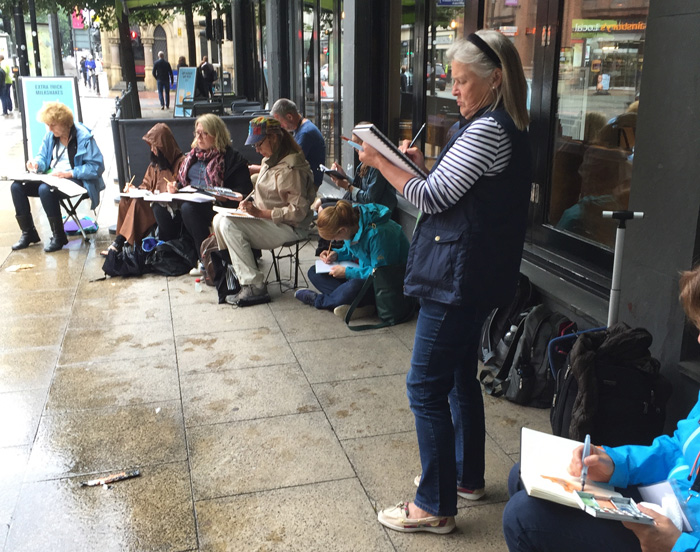
Light rain continued to come down but we had a bit of shelter under one awning and a tree. This area was reasonably sheltered by the wind but it was very noisy, so I had to use my loud voice.
Due to the disruptions (including the late start) I decided to scrap the third exercise and just talk through the concept based on what they had just done for the second exercise.
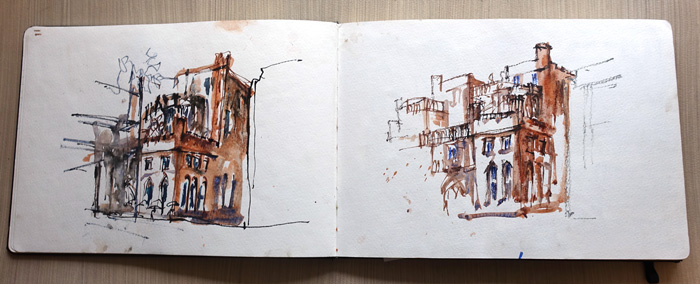
My exercises were specifically designed for the John Rylands library – how to see the underlying volumes and then apply the decoration over the top – but because of the limited views of the building (and the rain was getting a little heavier) some people drew some of the buildings on the other side of the road instead. This turned out fine as we could all see how the principles could apply to other buildings.
Lunchtime review
At the end of the workshop and I went back to my hotel room to have a quick rest and a review of the morning session and work out how to do it all again in the afternoon. Basically, in the morning session I had adjusted the prepared content on the run but I wanted to be a little more intentional in the afternoon.

Second workshop – refined content but more difficult conditions
The rain continued to come down in the afternoon, and it was tough to take the second group back to a less than ideal location – even more challenging because the ground was much wetter. However as this is the only chance I have with these people and my workshop was designed specifically for John Rylands, I decided to stick with my plan. I also thought that it was good to use this opportunity to show people that you can grit it out sketching on a wet day, and the best time to do it is in a group situation like this when you are surrounded by fellow sketchers for moral support. Urban sketchers are hardy! Aside: it was great to see Emma Fitzgerald not afraid of sitting out on the wet pavement!
I believed that the content as prepared was important enough to brave the elements but I am very aware of how tough the conditions were that afternoon! So I am very thankful that everyone stuck it out and were such good sports – thank you!
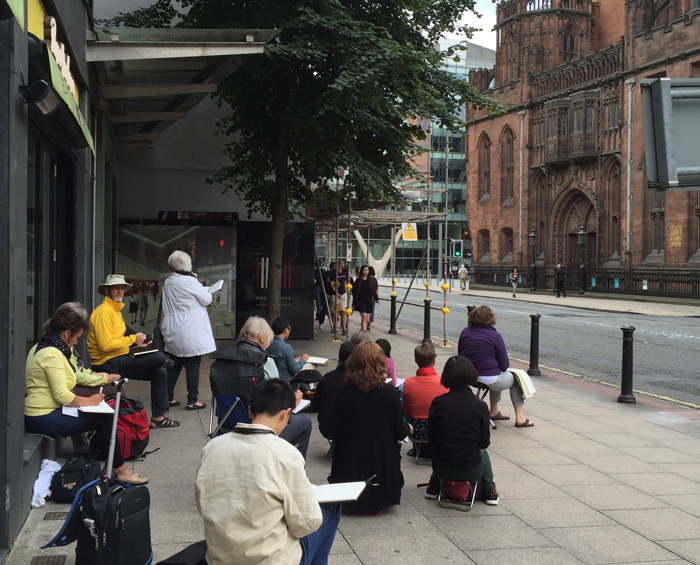
Third workshop – able to stick to my plan
The final session was on Saturday morning – so I had a whole day to recover. It was dry but really rather cold and windy. However, having the freedom to spread out on the pavement and see the building properly was wonderful!

Ah! so much easier and relaxing to just be able to teach and for the participants to be just able to sketch. Aside: sometimes on the last morning you have to make allowances for fatigue but I think we were all motivated by the dry weather. We even got a bit of sun!
Anyway, this has turned out to be a long article but I did want to share the experiences with you.
As a instructor at the Urban Sketchers Symposium you have to be really prepared and flexible at the same time. You have be keeping an eye out on all the external conditions, as well as teaching the content and providing enough personal feedback to everyone in the group. All in about 3 hours. You have to be prepared to make snap decisions and hope for the best.
In a way it encapsulates everything that I love about urban sketching – sure sometimes it is a bit challenging but it’s always worth it!
Despite the less than ideal conditions I really enjoyed each of my workshops! The work done by the groups in tough conditions was outstanding and each time I got lots of ideas and refined my delivery. Not to mention the fact that the people in each group were wonderful and a lot of fun.
The workshop evolved a little differently from what I had planned at home, but still with the main idea: to get more spontaneous architecture sketches by mixing up line and colour but always thinking about volumes.
For a detailed description of my workshop with downloadable handout please refer to this article.
If you want to find out more about this approach, plus heaps more specific tips for sketching buildings of any style and complexity, please check out my SketchingNow Buildings course


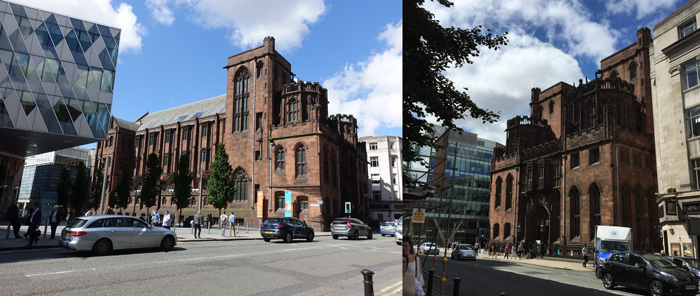
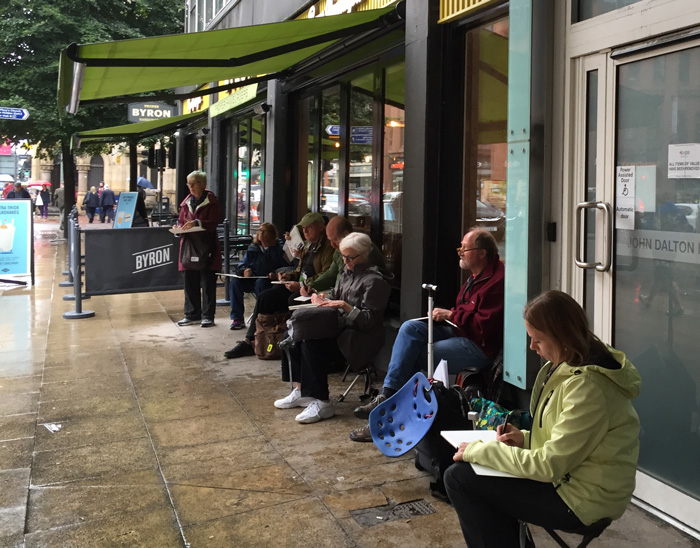
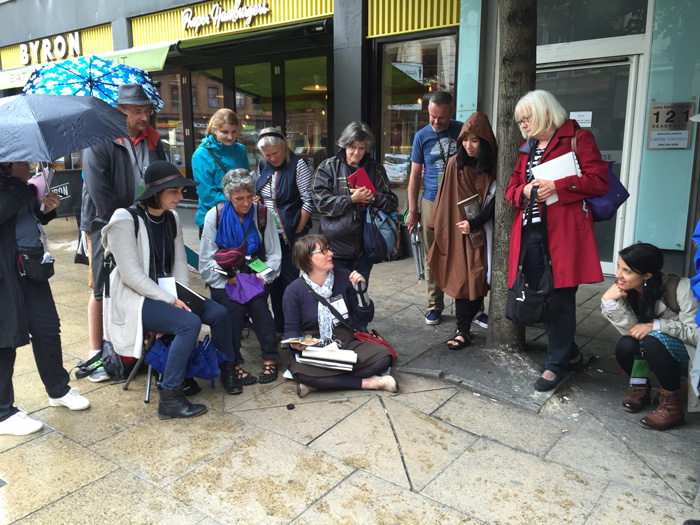
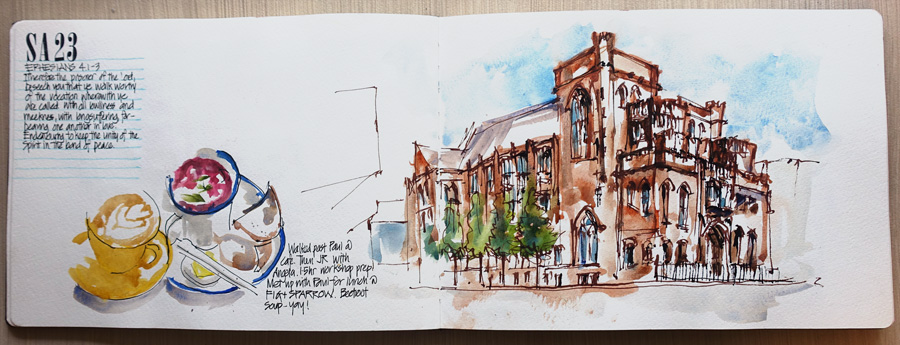
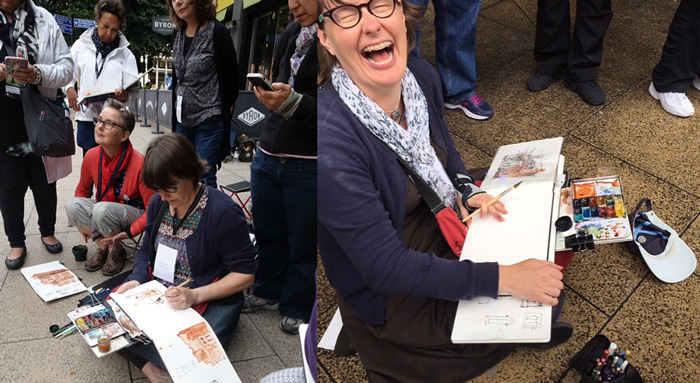
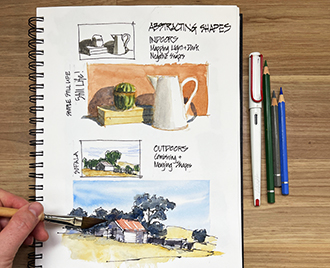

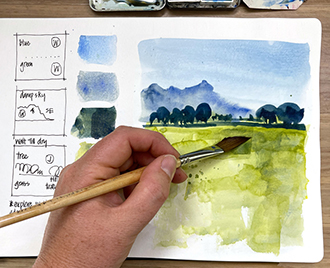
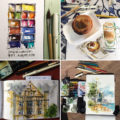
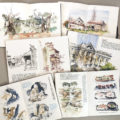
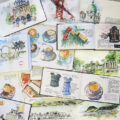
5 Comments
Liz. you made me absolutely breathless just reading of what is required of you people as Symposium presenters. It makes you all the more treasured.
Great insight into all of the preparation symposium instructors undertake and the demands of these 3 hour workshops! Thanks for sharing!
After reading this I REALLY hope I can get to the next one in Chicago!!!!
I was there in the rain with you in your first workshop, getting baptized in the Urban Sketcher tribe, getting rained on and more. And I can attest to your excellent good humor and brilliant teachings even in the worst possible conditions. The inspiration I brought home is worth more than any good weather would have provided!
Oh Liz your live workshop is definitely on my bucket list! I hope in 2 years they organize Symposium in Europe again, hopefully in Italy or Greece or other beautiful and warm location????
NEWSLETTER
Subscribe for first notification of workshop + online classes and more.